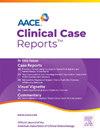A Beacon of Hope: Confronting Bardet-Biedl Syndrome in Pakistan's Health Care Frontier
IF 1.2
Q3 Medicine
引用次数: 0
Abstract
Background/Objective
This report presents a case of Bardet-Biedl Syndrome (BBS) in a 12-year-old boy from a nonconsanguineous Pakhtoon family in Peshawar, Pakistan, exploring its clinical complexity in a region with previously undocumented prevalence. First identified in the 19th century, BBS is a rare autosomal recessive disorder known for its variable symptomatology and genetic heterogeneity, primarily affecting children with a familial history of consanguinity.
Case Report
The subject exhibited hallmark features including polydactyly, syndactyly, developmental delays, central obesity, retinitis pigmentosa, and newly diagnosed diabetes mellitus, diverging from typical consanguineous patterns observed in most BBS cases and reflecting the diverse clinical manifestations of the syndrome. Despite challenges in diagnosis and management, accentuated by limited regional healthcare resources, a comprehensive management plan was formulated, leading to controlled blood sugar levels.
Discussion
This case emphasizes the need for increased awareness, improved diagnostic capabilities, and comprehensive management strategies in Pakistan to address the complexities of BBS effectively, particularly in settings with high consanguinity rates and specific cultural marital practices.
Conclusion
This case underscores the importance of heightened clinical awareness and early recognition among healthcare providers, particularly in regions where cultural practices, such as consanguineous marriages, may predispose to genetic syndromes like BBS.
希望的灯塔:在巴基斯坦的卫生保健前沿面对巴氏综合症
背景/目的本报告报告了一例来自巴基斯坦白沙瓦非近亲Pakhtoon家族的12岁男孩Bardet-Biedl综合征(BBS),探讨其在以前无文献记载的流行地区的临床复杂性。BBS于19世纪首次被发现,是一种罕见的常染色体隐性遗传病,以其多变的症状和遗传异质性而闻名,主要影响有家族血缘史的儿童。病例报告:该患者表现出多指、并指、发育迟缓、中枢性肥胖、视网膜色素变性和新诊断的糖尿病等标志性特征,与大多数BBS病例的典型近亲系不同,反映了该综合征的多种临床表现。尽管在诊断和管理方面存在挑战,但由于区域医疗资源有限,制定了综合管理计划,导致血糖水平得到控制。本病例强调了巴基斯坦需要提高认识,提高诊断能力和综合管理策略,以有效解决BBS的复杂性,特别是在高血缘率和特定文化婚姻习俗的环境中。结论:本病例强调了医疗保健提供者提高临床意识和早期认识的重要性,特别是在文化习俗(如近亲婚姻)可能易患BBS等遗传综合征的地区。
本文章由计算机程序翻译,如有差异,请以英文原文为准。
求助全文
约1分钟内获得全文
求助全文
来源期刊

AACE Clinical Case Reports
Medicine-Endocrinology, Diabetes and Metabolism
CiteScore
2.30
自引率
0.00%
发文量
61
审稿时长
55 days
 求助内容:
求助内容: 应助结果提醒方式:
应助结果提醒方式:


